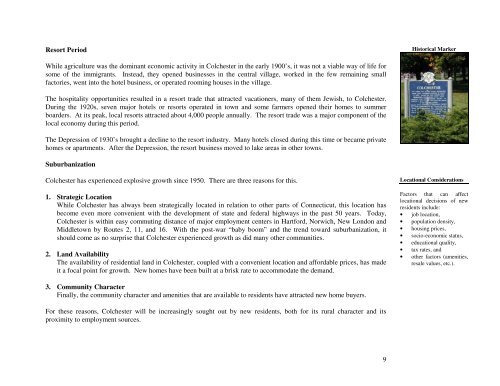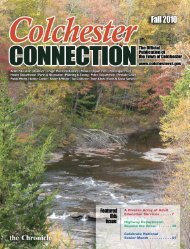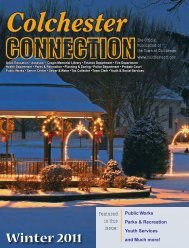2 - Town of Colchester
2 - Town of Colchester
2 - Town of Colchester
- No tags were found...
Create successful ePaper yourself
Turn your PDF publications into a flip-book with our unique Google optimized e-Paper software.
Resort Period<br />
Historical Marker<br />
While agriculture was the dominant economic activity in <strong>Colchester</strong> in the early 1900’s, it was not a viable way <strong>of</strong> life for<br />
some <strong>of</strong> the immigrants. Instead, they opened businesses in the central village, worked in the few remaining small<br />
factories, went into the hotel business, or operated rooming houses in the village.<br />
The hospitality opportunities resulted in a resort trade that attracted vacationers, many <strong>of</strong> them Jewish, to <strong>Colchester</strong>.<br />
During the 1920s, seven major hotels or resorts operated in town and some farmers opened their homes to summer<br />
boarders. At its peak, local resorts attracted about 4,000 people annually. The resort trade was a major component <strong>of</strong> the<br />
local economy during this period.<br />
The Depression <strong>of</strong> 1930’s brought a decline to the resort industry. Many hotels closed during this time or became private<br />
homes or apartments. After the Depression, the resort business moved to lake areas in other towns.<br />
Suburbanization<br />
<strong>Colchester</strong> has experienced explosive growth since 1950. There are three reasons for this.<br />
1. Strategic Location<br />
While <strong>Colchester</strong> has always been strategically located in relation to other parts <strong>of</strong> Connecticut, this location has<br />
become even more convenient with the development <strong>of</strong> state and federal highways in the past 50 years. Today,<br />
<strong>Colchester</strong> is within easy commuting distance <strong>of</strong> major employment centers in Hartford, Norwich, New London and<br />
Middletown by Routes 2, 11, and 16. With the post-war “baby boom” and the trend toward suburbanization, it<br />
should come as no surprise that <strong>Colchester</strong> experienced growth as did many other communities.<br />
2. Land Availability<br />
The availability <strong>of</strong> residential land in <strong>Colchester</strong>, coupled with a convenient location and affordable prices, has made<br />
it a focal point for growth. New homes have been built at a brisk rate to accommodate the demand.<br />
Locational Considerations<br />
Factors that can affect<br />
locational decisions <strong>of</strong> new<br />
residents include:<br />
• job location,<br />
• population density,<br />
• housing prices,<br />
• socio-economic status,<br />
• educational quality,<br />
• tax rates, and<br />
• other factors (amenities,<br />
resale values, etc.).<br />
3. Community Character<br />
Finally, the community character and amenities that are available to residents have attracted new home buyers.<br />
For these reasons, <strong>Colchester</strong> will be increasingly sought out by new residents, both for its rural character and its<br />
proximity to employment sources.<br />
9







